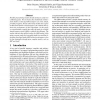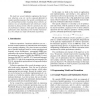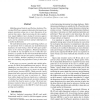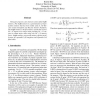IPPS
1999
IEEE
14 years 4 months ago
1999
IEEE
Abstract. In this paper, we present self-avoiding walks as a novel technique to linearize" a triangular mesh. Unlike space- lling curves which are based on a geometric embeddi...
IPPS
1999
IEEE
14 years 4 months ago
1999
IEEE
The main contribution of this work is to propose efficient randomized leader election and initialization protocols for Packet Radio Networks (PRN, for short). As a result of the i...
IPPS
1999
IEEE
14 years 4 months ago
1999
IEEE
Abstract. We describe how the PVS verification system has been used to verify a safety property of a garbage collection algorithm, originally suggested by Ben-Ari. The safety prope...
IPPS
1999
IEEE
14 years 4 months ago
1999
IEEE
Parallel programming models should attempt to satisfy two conflicting goals. On one hand, they should hide architectural details so that algorithm designers can write simple, port...
IPPS
1999
IEEE
14 years 4 months ago
1999
IEEE
We study how several collective operations like broadcast, reduction, scan, etc. can be composed efficiently in complex parallel programs. Our specific contributions are: (1) a fo...
IPPS
1999
IEEE
14 years 4 months ago
1999
IEEE
A structured approach to parallel programming allows to construct applications by composing skeletons, i.e., recurring patterns of task- and data-parallelism. First academic and co...
IPPS
1999
IEEE
14 years 4 months ago
1999
IEEE
Multidimensional Analysis and On-Line Analytical Processing (OLAP) uses summary information that requires aggregate operations along one or more dimensions of numerical data value...
IPPS
1999
IEEE
14 years 4 months ago
1999
IEEE
This paper proposes a method for reducing the maximum degree of vertices in graphs that maintain optimal broadcast time when a vertex can call a vertex at distance at most k durin...
IPPS
1999
IEEE
14 years 4 months ago
1999
IEEE
This paper proposes a new memory system called shuffle memory. The shuffle memory is a generalization of transposition memory that has been widely used in 2-D Discrete Cosine Tran...
IPPS
1999
IEEE
14 years 4 months ago
1999
IEEE
This paper presents the Pure/Epos approach to deal with the high complexity of adaptable operating systems and also to diminish the distance between application and operating syste...







